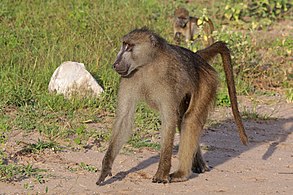Post by dinosauria101 on May 5, 2019 5:11:47 GMT 5
Cape Leopard - Panthera pardus melanotica
The leopard, Panthera pardus, is a member of the Felidae family and the smallest of the four "big cats" in the genus Panthera, the other three being the tiger, lion, and jaguar. Cape Leopards or Panthera pardus melanotica are much smaller than the African Leopard (Panthera pardus) found in the Kruger National Park. These have an average weight of 61kg for males, while their Cape counterparts average just over half that. In the Western Cape, leopards are significantly smaller, males averaging 32 kg and females 20 kg, which makes them in many instances smaller than a large male Caracal.

Chacma Baboon - Papio ursinus
The Chacma baboon (Papio ursinus), also known as the Cape baboon, is, like all other baboons, from the Old World monkey family. With a body length of up to 115 cm and a weight from 15 to 31 kg, it is among the largest and heaviest baboon species. The Chacma is generally dark brown to gray in color, with a patch of rough hair on the nape of its neck. Unlike the northern baboon species (the Guinea, Hamadryas, and Olive baboons), Chacma males do not have a mane. Perhaps the most distinctive feature of this baboon is its long, downward sloping face.] Males can have canine teeth as long as 2 inches (longer than a lion's canine teeth). Baboons are sexually dimorphic, males being considerably larger than females. The Chacma baboon is found in southern Africa, ranging from South Africa north to Angola, Zambia, and Mozambique. Size and color vary within that range. Chacmas usually live in social groups composed of multiple adult males, adult females, and their offspring. Occasionally, however, very small groups form that include only a single adult male and several adult females.

Credit to Wikipedia
The leopard, Panthera pardus, is a member of the Felidae family and the smallest of the four "big cats" in the genus Panthera, the other three being the tiger, lion, and jaguar. Cape Leopards or Panthera pardus melanotica are much smaller than the African Leopard (Panthera pardus) found in the Kruger National Park. These have an average weight of 61kg for males, while their Cape counterparts average just over half that. In the Western Cape, leopards are significantly smaller, males averaging 32 kg and females 20 kg, which makes them in many instances smaller than a large male Caracal.

Chacma Baboon - Papio ursinus
The Chacma baboon (Papio ursinus), also known as the Cape baboon, is, like all other baboons, from the Old World monkey family. With a body length of up to 115 cm and a weight from 15 to 31 kg, it is among the largest and heaviest baboon species. The Chacma is generally dark brown to gray in color, with a patch of rough hair on the nape of its neck. Unlike the northern baboon species (the Guinea, Hamadryas, and Olive baboons), Chacma males do not have a mane. Perhaps the most distinctive feature of this baboon is its long, downward sloping face.] Males can have canine teeth as long as 2 inches (longer than a lion's canine teeth). Baboons are sexually dimorphic, males being considerably larger than females. The Chacma baboon is found in southern Africa, ranging from South Africa north to Angola, Zambia, and Mozambique. Size and color vary within that range. Chacmas usually live in social groups composed of multiple adult males, adult females, and their offspring. Occasionally, however, very small groups form that include only a single adult male and several adult females.

Credit to Wikipedia



